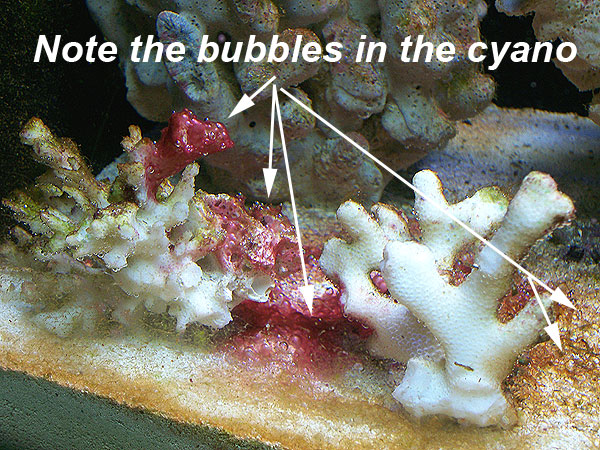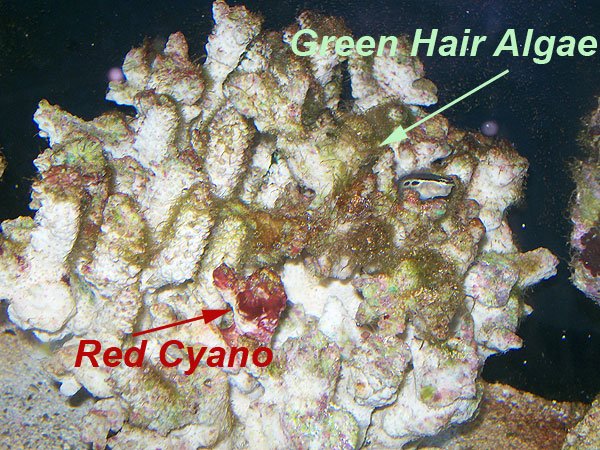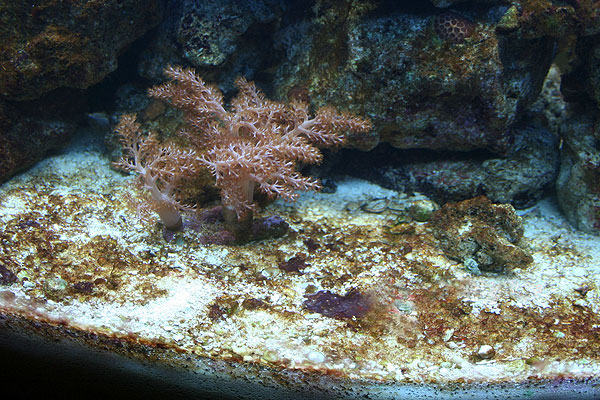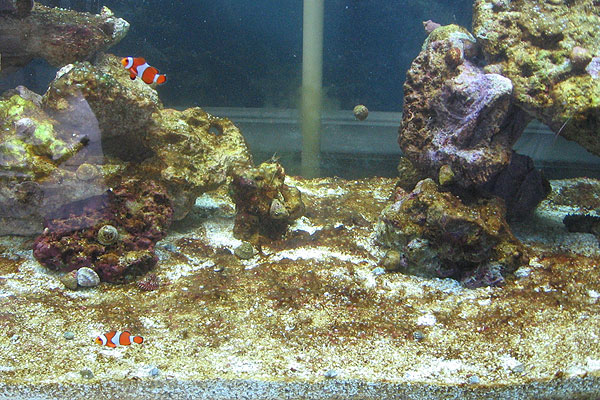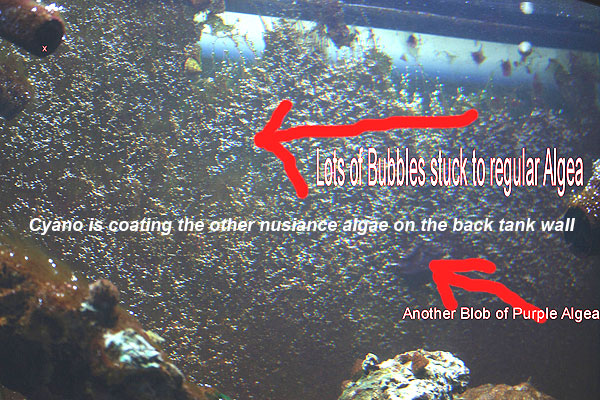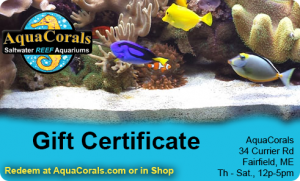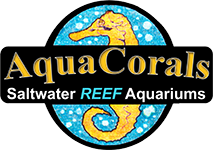
Algae, Cyanobacteria: Red/Brown/Black & Dinoflagellates
This article focuses on Cyano but the causes & remedies are the same for Algae & Dinoflagellates too.
A scourge of this hobby is commonly known as "Red Slime Algae". It's NOT an algae but rather a bacteria - Cyanobacteria to be exact. Almost every hobbyist will deal with this issue at some point, most often at the end of a new tank cycling. The common name "Red Slime Algae" is deceptive as this bacteria can "look" brown, Purple, red, even black depending on the lighting above it & it's stage in growth/thickness. Most commonly seen in the beginning stages as a "reddish/brown dusting" on the sand/rocks if left untreated it will quickly become thicker, even stringy looking, can have little bubbles trapped in it & carpet your sand, rocks & even your corals! Cyanobacteria is super toxic! It can & will kill corals, fish & inverts! Pics below of how it can look - quite different yet all the same bad stuff! Cyano!
Cyanobacteria is a bacteria that is always present in our tanks. When it grows in enough numbers so it becomes "visible" & more "physical" it is because it has a food source allowing it to grow (same for Algae & Dinoflagellates too). That food source is primarily high levels of dissolved organic carbon compounds (DOCs). Cyano, algae & Dinoflagellates "blooms" or "breakouts" can be caused by just one ... or a combination of the following factors:
Overfeeding
Poor skimming - (not the right size for system) OR no skimmer on a system - Note - you can never over skim a system!
Not using an RO water filter or you have an ineffective RO water filter, i.e., any brand not using a Filmtec membrane
RO membrane not fully "seated" into it's housing allowing the water to bypass the membrane
Infrequent water changes (should be 10% weekly)
Improper filtration, i.e., sand bed not deep enough &/or too little rock
Nutrients dumped from a new setup or transfer cycle
Liquid invertebrate and gelatin based foods - HIGH sources of DOC
Old style bulbs (flo, halides etc.) giving off a lower color temperature - Most of these bulbs need changing every 12 months
LED lights in the wrong color temp (like freshwater systems used for saltwater is a no, no) or you have your reef lighting channels more in the red spectrum.
Poor water circulation, not enough water flow inside the tank & low oxygen saturation from your overflow system operating under the 10x per hour rate.
Nutrients unlocked from disturbing a sand bed in moving a tank or re-sanding.
How to get rid of Cyano, Algae & Dinoflagellates? First, correct any possible cause listed above.
To remedy a bloom of cyano: Physically remove the cyano (do not stir it up or try to net it out as this just breaks it up & further disperses it in your tank) by siphoning it out & turn off your lights for 3 days (your corals will be fine). Siphoning may require repeating daily if cyano spots reappear. Siphon until the cyano no longer appears. Bite the bullet & do it though! Siphoning & physically removing it is the "key" to success. Don't worry about sucking up a bit of your sand bed. It can easily be replaced (if necessary) with more live topper sand that doesn't need rinsing.
NOTE! Never, ever use products like Chemiclean which are antibiotic based & will kill your good bacteria as well as the bad & cause you even more problems shortly after application! It removes nothing but only kills the bacteria! The toxins in cyano are then fully released & cause at the very least, irritation to corals & all livestock. Again, stay away from these quick fix products & apply some elbow grease to remedy the problem. If you do not correct what caused the bloom to begin with, it's just going to return. FIX the problems.
To remedy a bloom of algae: Physically remove algae by:
1. If possible, by removing any affected rocks, take them to a sink, scrub algae with a clean old toothbrush, quick rinse of debris with lukewarm water & place rock back in your tank. If the rock has coral on it, most can withstand a couple minutes out of the water & even the quick freshwater rinse but return to tank immediately. I would only do one coral rock in a out of tank scrub session as many release chemicals from the stress.
2. Scrub rocks in tank while at the same time siphoning out the algae debris.
3. Add algae snails to the tank in numbers as most are slow to work. Astreas (for rocks & glass), Ceriths (for sand & lower rocks) & Turbos (use only in tanks where corals are large enough not to get pushed over by them as they are bulls in a china closet but great against turf algae Astreas & Ceriths won't touch).
To remedy a bloom of Dinos: Same as for cyano.
For ALL 3 scourges you should add ROX carbon & a or multiple (depending on the size system) Polyfilters to remove the toxins & DOCs already in the system.
This method WILL work...but only if you make it work...by doing the work.
BEWARE of chemical products that claim to rid the tank of these scourges!! I cannot stress this enough! For cyano, the most common products are antibiotic based and will also kill your good bacteria as well as the bad thus reducing/eliminating your system's ability to break down wastes & increasing your DOC levels. Also, the toxins in the cyano are left behind & can continue killing too! Cyano WILL almost always return if only chemically treated and the source(s) of the problem (DOCs, water flow, lighting etc.) are not dealt with. You MUST be prepared to intervene as I stated above. It warrants repeating...correct the cause & siphon, siphon, siphon! Your tank & beloved livestock are depending on you.
--------------------------------------------------------------------
Customer Feedback:
Hi Penny,
I followed the advice on your website regarding the eradication of cyano and it seems to have worked exactly as you said it would. Yesterday was the first day back with lights on, and for the first time in 6 weeks I did not get any residual cyano growth the day after a water change! I've also switched up the eating regimen as per your advice, and although it's probably too early to tell how that impacts the health of my tank, I think it's safe to say that the cyano is gone for good this time!
Thanks again!
John

